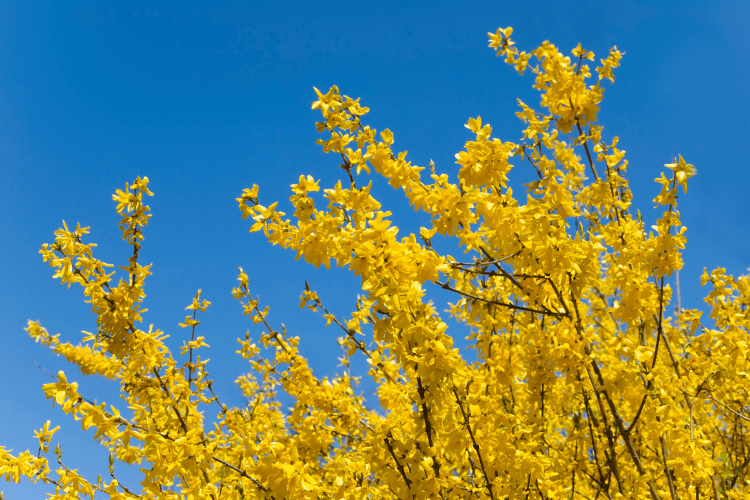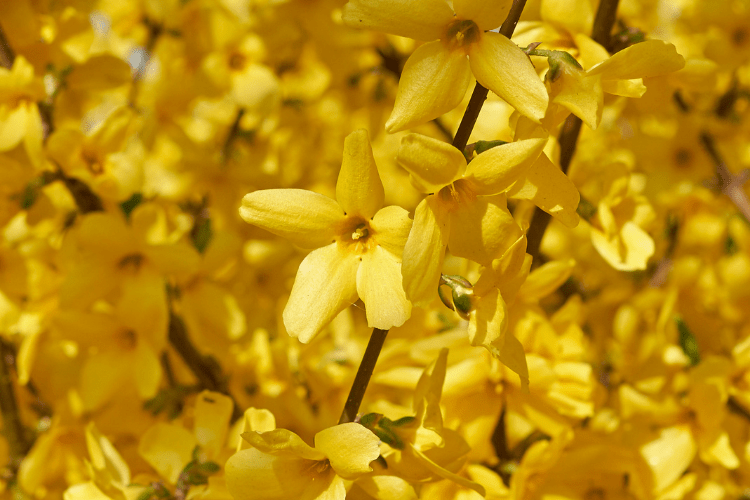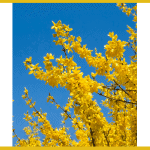Forsythia is our cue that Spring is officially coming. These low maintenance and fast-growing shrubs bloom with bright yellow flowers in early Spring. Here are some tips for how to grow Forsythia and add this stunning beauty to your landscaping.
Typically Forsythia is an easy-to-grow shrub. They are best suited for hardiness zones 5-9 and prefer full sun. It’s a fast-growing shrub and makes an excellent backdrop as a spring/summer hedge. The stunning yellow flowers complement any color scheme.

How to Grow Forsythia
Here are the top things you need to know before planting Forsythia.
Will Forsythia Grow Where I Live?
First, check out your planting zones. You can do this by adding your zip code to the USDA Hardiness Map. It is best suited for zones 5-9 and it can tolerate down to negative 20 degrees Fahrenheit which allows for a very large portion of the United States and the United Kingdom to grow this shrub.
What Kind of Sunlight and Soil Does Forsythia Need?
Forsythia prefers full sun conditions to grow. This generally means at least 6 full hours of direct sunlight.
It prefers well-drained fertile soil to thrive. It doesn’t like soggy roots, so you may need to amend your soil before planting. You can use organic matter like leaf mulch or even sand to improve the drainage in your soil.
When Should I Plant Forsythia?
Most hardiness zones will plant these shrubs in the fall. However, if you’re in one of the colder zones, you may want to wait until spring – after the last frost or freeze.
How to Plant Forsythia
You can buy a plant from any local garden center. Dig a hole that is at least 1 foot wider than the rootball. Dig down around 1 foot if you need to add in organic matter for your soil, or about 8 inches if you don’t.
Add your plant to the hole about 2 inches higher than your soil. Continue adding soil around your plant and then add mulch to hold in water. Keep mulch a few inches away from the trunk so you don’t encourage root rot and eventual plant death.
Keep the plant watered until established and as it matures it becomes incredibly drought resistant.
Grow From Cuttings
You can add more plants to your landscaping by growing from cuttings. We did this from a larger plant in our front yard. There is a formal way to do this. However, I’ll be honest – we just took two of the branches and rooted them in another organic-rich area of the yard and we now have two new plants.
How Big Does Forsythia Grow?
These plants will get between 5-8 feet wide and tall. The branches can be long and spindly so be mindful of that if you’re planting close to structures or sidewalks.
Make sure you give them room to grow and don’t attempt to prune them into a neat shape or you could stop the blooms. And the blooms are the best part of this shrub. It’s best if left to grow a bit wild.
If you need to prune any dead branches, do so after flowering or in the winter.
What Does Forsythia Look Like in Winter?
Forsythia loses its leaves in the winter which means it is a deciduous shrub. It will be long branches with no leaves or flowers until Spring comes. Don’t cut those stems though. This old wood is what is going to give you your blooms next season.
How Long Do Forsythia Blooms Last?
Unfortunately, these gorgeous yellow blooms are short-lived. They appear at the first signs of warmer temperatures and sadly only last for a few weeks.
Once the blooms are gone, they are replaced with beautiful green foliage that will last into the fall. In the fall, the foliage will turn a subtle goldish or purplish color, but nothing too showy. Then the plant will drop its leaves and go dormant until the next spring.
Do Forsythia Shrubs Have Deep Roots?
Forsythia roots can go about 2 feet deep and can spread out from a dense taproot. Considering the mature size of the plant this can mean removing lots of little roots attached to one main root if you choose to remove it.
It’s also best to avoid planting over septic lines or too close to them due to the fact that the roots could grow as deep as the lines. As a general rule, don’t plant anything on top of septic lines unless you want to deal with potentially expensive problems one day.
Where Should I Use Forsythia in my Landscaping?
Anywhere is the good answer. However, keep in mind that if using as a hedge, you won’t get privacy or foliage during the winter months. It will make a stunning show of yellow for a few weeks each Spring though.
These plants are great on their own, flanking a driveway (keep far enough away to allow for spindly branches), or as a backdrop for smaller shrubs like Azaleas.
Due to its striking yellow blooms, any plant that blooms in a contrasting color will look amazing with Forsythia. Think pinks, reds, purples.
What Varieties are Available?
There are 11 different species of Forsythia. None have dramatically different characteristics than the other. They are widely available at your local garden centers.
Are Forsythia Shrubs Pest, Disease, or Deer Resistant?
Forsythia shrubs are deer resistant meaning deer don’t typically snack on this plant. They are virtually free of pests and diseases making them an ideal perennial shrub that you can plant and enjoy for years to come.

Shop For Forsythia
You can generally find Forsythia plants at local garden stores, nurseries, or even online at places like Planting Tree.
Hopefully, this helps with everything you need to know for how to grow Forsythia!
For more shrub ideas:
7 Fast Growing Evergreen Shrubs and Trees
Low Maintenance Shrubs for the Front of the House





